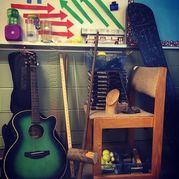|
Play with the projection of a vector on another vector...
0 Comments
My Calculus students needed some work with piecewise functions, and seemed to enjoy the slope puzzles we had been doing periodically so I had them create their own as a mini assignment.
The requirements were:
Here is an example of one of the really interesting submissions: The rest of the submissions: Samantha and Katherine (Reciprocal): https://www.desmos.com/calculator/k6ta1hpjr1 Melvin (Polynomial): https://www.desmos.com/calculator/pcytghpgp2 Malcom and Jonathan (Absolute value): https://www.desmos.com/calculator/s18vpu6eyt Ahillan (Sine): https://www.desmos.com/calculator/moj40jbkeg Gerardo and Patrick (Sine): https://www.desmos.com/calculator/02bxuszbjn Jose (Cosine): https://www.desmos.com/calculator/i9jqcvknsw Nana S (Sine): https://www.desmos.com/calculator/7aam6jjs0p Lucas (Polynomial): https://www.desmos.com/calculator/84qr54wycg Almendra (Sine): https://www.desmos.com/calculator/gkoosz85js Noyangbe (Radical): https://www.desmos.com/calculator/ycku94ltoe Monica (Radical): https://www.desmos.com/calculator/xm17lhvipf Lawrenda (Polynomial): https://www.desmos.com/calculator/x4wxfuoerk Nardos and Priscilla (Cosine): https://www.desmos.com/calculator/70rrejqt3y Mirabel (Polynomial): https://www.desmos.com/calculator/ttg4pb1uf9 Brian and Joshua (Reciprocal): https://www.desmos.com/calculator/c0ucoms3w5 Jad and Nathan (Sine): https://www.desmos.com/calculator/h6u1bbz00f Faith (Sine): https://www.desmos.com/calculator/t9ujrlfflz Donovan and Ranvir (Reciprocal): https://www.desmos.com/calculator/hz19ixgc0k Anitha (Sine): https://www.desmos.com/calculator/0kxlczcguw Jayestha (20th degree polynomial, sine, absolute value): https://www.desmos.com/calculator/xghnljuqcu Ethan (Reciprocal): https://www.desmos.com/calculator/llggi5zedd Nana O and Michael (Root): https://www.desmos.com/calculator/dlfqhn8cuu Kurtis (Reciprocal): https://www.desmos.com/calculator/bnrqwevbne
Get an intuitive understanding of how the slope of a tangent can be approximated with a secant...
Play with the Desmos file by opening it in the Desmos web app.
Why is Calculus only taught in Grade 12? Students need to have the algebra background to be able to calculate "difference quotients" and manipulate limits.
But do you need to be proficient in algebra to understand Calculus? Nope. You just need a basic understanding of rate of change. "Slope Puzzles" have students predict the graph of the derivative of a piecewise function. The answer is revealed by sliding the black point to the right...
Link to Slope Puzzle 1 Desmos
I believe there is way too much emphasis on algebra in the high school math curriculum. Not enough time is spent building a deep understanding of the concepts.
Even though it's saved for the end of Grade 12, as a rite of passage to mathematical prowess, differential calculus isn't a difficult concept! Even my Grade 9's could solve this puzzle after some practice.
Link to Slope Puzzle 2 Desmos
Solving these puzzles builds an intuitive understanding of differentiation without having to perform any algebra at all. I plan on using these puzzles in my Calculus class from the first day of the semester to help build that intuition.
I also plan on having Calculus students create their own Slope Puzzles in Desmos as a way to test their understanding of piecewise functions and function continuity.
Move the x-intercepts of the polynomial around.
Open in Desmos to change the degree of the polynomial (by activating a different functions) or change the 'a' value to scale if things get too crazy. |
Lukas NottenTCDSB Educator Archives
November 2019
Categories |



 RSS Feed
RSS Feed
